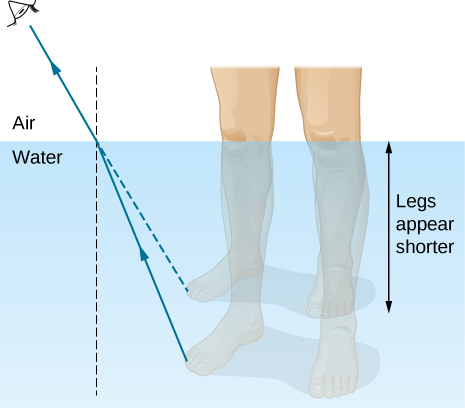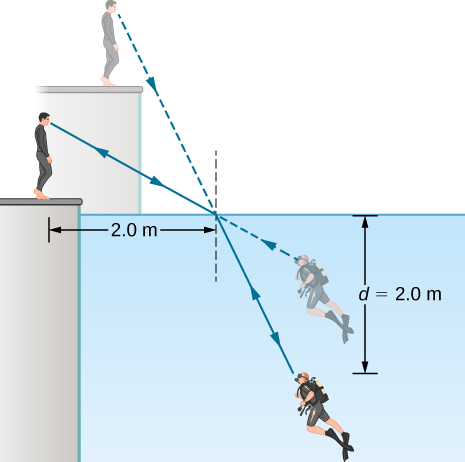| << Chapter < Page | Chapter >> Page > |
Here and are the indices of refraction for media 1 and 2, and and are the angles between the rays and the perpendicular in media 1 and 2. The incoming ray is called the incident ray, the outgoing ray is called the refracted ray, and the associated angles are the incident angle and the refracted angle, respectively.
Snell’s experiments showed that the law of refraction is obeyed and that a characteristic index of refraction n could be assigned to a given medium and its value measured. Snell was not aware that the speed of light varied in different media, a key fact used when we derive the law of refraction theoretically using Huygens’s principle in Huygens’s Principle .
Entering known values,
Explore bending of light between two media with different indices of refraction. Use the “Intro” simulation and see how changing from air to water to glass changes the bending angle. Use the protractor tool to measure the angles and see if you can recreate the configuration in [link] . Also by measurement, confirm that the angle of reflection equals the angle of incidence.
Entering known values,
The angle is thus
Check Your Understanding In [link] , the solid with the next highest index of refraction after diamond is zircon. If the diamond in [link] were replaced with a piece of zircon, what would be the new angle of refraction?
Diffusion by reflection from a rough surface is described in this chapter. Light can also be diffused by refraction. Describe how this occurs in a specific situation, such as light interacting with crushed ice.
Will light change direction toward or away from the perpendicular when it goes from air to water? Water to glass? Glass to air?
“toward” when increasing n (air to water, water to glass); “away” when decreasing n (glass to air)
Explain why an object in water always appears to be at a depth shallower than it actually is?
Explain why a person’s legs appear very short when wading in a pool. Justify your explanation with a ray diagram showing the path of rays from the feet to the eye of an observer who is out of the water.
A ray from a leg emerges from water after refraction. The observer in air perceives an apparent location for the source, as if a ray traveled in a straight line. See the dashed ray below.

Explain why an oar that is partially submerged in water appears bent.
Unless otherwise specified, for problems 1 through 10, the indices of refraction of glass and water should be taken to be 1.50 and 1.333, respectively.
A light beam in air has an angle of incidence of at the surface of a glass plate. What are the angles of reflection and refraction?
A light beam in air is incident on the surface of a pond, making an angle of with respect to the surface. What are the angles of reflection and refraction?
reflection, ; refraction,
When a light ray crosses from water into glass, it emerges at an angle of with respect to the normal of the interface. What is its angle of incidence?
A pencil flashlight submerged in water sends a light beam toward the surface at an angle of incidence of . What is the angle of refraction in air?
Light rays from the Sun make a angle to the vertical when seen from below the surface of a body of water. At what angle above the horizon is the Sun?
The path of a light beam in air goes from an angle of incidence of to an angle of refraction of when it enters a rectangular block of plastic. What is the index of refraction of the plastic?
1.53
A scuba diver training in a pool looks at his instructor as shown below. What angle does the ray from the instructor’s face make with the perpendicular to the water at the point where the ray enters? The angle between the ray in the water and the perpendicular to the water is .

(a) Using information in the preceding problem, find the height of the instructor’s head above the water, noting that you will first have to calculate the angle of incidence. (b) Find the apparent depth of the diver’s head below water as seen by the instructor.
a. 2.9 m; b. 1.4 m

Notification Switch
Would you like to follow the 'University physics volume 3' conversation and receive update notifications?